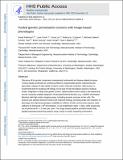Pooled genetic perturbation screens with image-based phenotypes
Author(s)
Feldman, David; Funk, Luke; Le, Anna; Carlson, Rebecca J; Leiken, Michael D; Tsai, FuNien; Soong, Brian; Singh, Avtar; Blainey, Paul C; ... Show more Show less
DownloadPublished version (2.108Mb)
Publisher with Creative Commons License
Publisher with Creative Commons License
Creative Commons Attribution
Terms of use
Metadata
Show full item recordAbstract
Discovery of the genetic components underpinning fundamental and disease-related processes is being rapidly accelerated by combining efficient, programmable genetic engineering with phenotypic readouts of high spatial, temporal and/or molecular resolution. Microscopy is a fundamental tool for studying cell biology, but its lack of high-throughput sequence readouts hinders integration in large-scale genetic screens. Optical pooled screens using in situ sequencing provide massively scalable integration of barcoded lentiviral libraries (e.g., CRISPR perturbation libraries) with high-content imaging assays, including dynamic processes in live cells. The protocol uses standard lentiviral vectors and molecular biology, providing single-cell resolution of phenotype and engineered genotype, scalability to millions of cells and accurate sequence reads sufficient to distinguish >106 perturbations. In situ amplification takes ~2 d, while sequencing can be performed in ~1.5 h per cycle. The image analysis pipeline provided enables fully parallel automated sequencing analysis using a cloud or cluster computing environment.
Date issued
2022Department
Massachusetts Institute of Technology. Department of Biological EngineeringJournal
Nature Protocols
Publisher
Springer Science and Business Media LLC
Citation
Feldman, David, Funk, Luke, Le, Anna, Carlson, Rebecca J, Leiken, Michael D et al. 2022. "Pooled genetic perturbation screens with image-based phenotypes." Nature Protocols, 17 (2).
Version: Final published version